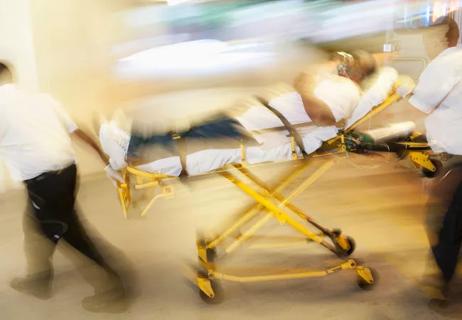Q&A with Cleveland Clinic’s stroke program leader on secrets of success
In April 2018, Cleveland Clinic’s Cerebrovascular Center completed its Comprehensive Stroke Center (CSC) recertification survey by the Joint Commission, passing with a rare achievement: zero “Requirements for Improvement” (RFIs).
Advertisement
Cleveland Clinic is a non-profit academic medical center. Advertising on our site helps support our mission. We do not endorse non-Cleveland Clinic products or services. Policy
Nationwide, the biennial two-day survey typically finds several deficiencies in each institution that must be addressed to maintain the prestigious CSC status.
Andrew Russman, DO, who heads Cleveland Clinic’s Stroke Program and serves as Medical Director of its Comprehensive Stroke Center, recently shared with Consult QD how his team met the Joint Commission’s CSC standards so comprehensively in this latest survey.
Q: Can you provide a bit of background? How rigorous is the recertification survey?
A: Certification as a CSC is more than a general recognition of having an efficiently run healthcare center; numerous rigorously defined standards and guidelines must be met. Multiple stroke care services must be available 24/7, and many must be provided within a set number of minutes. The institution also must present evidence of low complication rates for various procedures.
CSC certification is the highest accreditation offered by the Joint Commission and signifies that an institution is capable of handling the most complex cases and provides patients with the best opportunity for stroke recovery. Achieving zero RFIs during a recertification survey is an extraordinary accomplishment; I am not aware of any other institution that has done so.
Q: What enabled Cleveland Clinic to earn such a good outcome? Are there processes you can share?
A: I think several elements are critical. Let me lay them out one by one.
Achieving buy-in from all stakeholders. We started by educating everyone in our stroke program about the importance of obtaining CSC certification and garnering consensus to work toward that goal. We actually drew up a detailed charter with the roles and responsibilities of all involved employees and had key stakeholders sign it. This helped ensure that everyone — from those in the trenches providing patient care to the top levels of the administration — was on the same page for achieving and maintaining top-notch standards.
Advertisement
Devoting adequate resources for success. In response to an identified need, we gained approval from the administration to hire and support an additional program manager dedicated to meeting all the CSC certification requirements.
Continuous performance monitoring. For decades, Cleveland Clinic has routinely collected performance data on our services and provided it openly to everyone within the institution. This allows us to compare ourselves with others and with national data so that gaps can be readily detected. It also enables routine monitoring of trends and improvement.
Identifying and addressing gaps. We have multiple teams that scrutinize the data and perform gap analyses to compare our actual performance with a desired performance. We break down all components of the service in question and identify barriers to achieving our goals. We frequently participate in SOLVE (Solutions for Value Enhancement) projects, in which we take a specific issue for improvement — such as accelerating “door-to-groin time” for initiating endovascular therapy — and focus intensely on it. We create teams that write up new protocols, conduct practice walk-throughs, and continuously monitor impacts of new interventions.
Enlisting outside consultation. Periodically, we augment our internal performance reviews with an evaluation from an outside expert. This usually consists of a full-day run-through of a typical Joint Commission recertification survey. Such mock surveys are available from the American Heart Association or can be provided by other CSCs. Cleveland Clinic frequently provides this service to others. This culture of collaboration rather than competition among CSCs brings everyone closer to the ultimate goal of improving patient outcomes across the board.
Advertisement
Q: Did the survey evaluators call out specific services as exceptional — or cite any areas for improvement?
A: The Joint Commission team was impressed by the knowledge and dedication of our caregivers in many departments, particularly our main campus emergency department, the neuro ICU, the neuro step-down units, and the neurointerventional radiology and postcarotid procedure areas. They praised our careful and consistent documentation of care management plans and the integration of our electronic medical record with our stroke care path. They also commented that the continuing stroke education we provide to all caregivers — including nurses, technicians, residents and fellows — is exceptional.
Did they find room for improvement? Of course. They pointed out issues that did not qualify as RFIs but can serve as a focus for further refinement. We plan on tending to those next.
One memorable comment from an evaluator was: “You seem to have the system hard-wired” for ensuring that you meet CSC expectations for all standards of care. I think this element of “hard-wiring” — having a deep-rooted and pervasive culture of improvement with a well-run system to carry it out — is the key to our success.
Advertisement
Advertisement

Analysis characterizes geography’s sizable role in urban/rural care divides

New analysis details the disparities and points to opportunities for improvement

In survey, both female and male respondents reporting ongoing concerns

Group advocates for stroke systems of care supported by telestroke and proper reimbursement

Dr. Gregory Nemunaitis looks to build on his history of integrating education, research and patient care

Mission centers on screening, prevention for at-risk women in their 30s to 60s

One-year results from national database confirm enduring benefits

Q&A with Dr. Andrew Russman, Medical Director of our Comprehensive Stroke Center